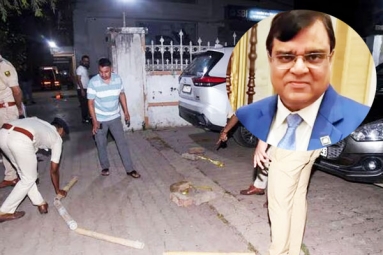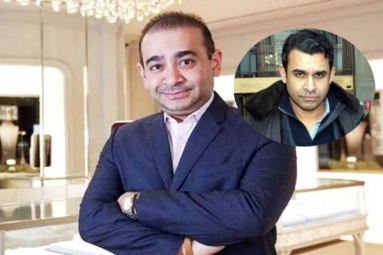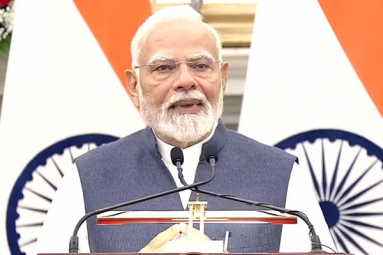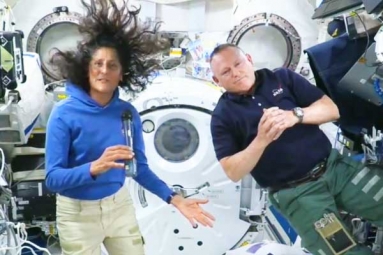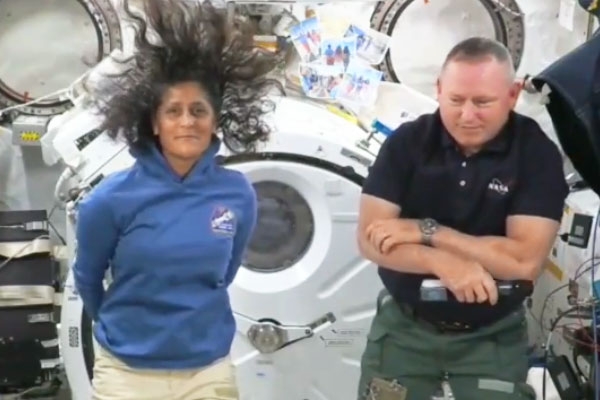
(Image source from: x.com/NASA)
The upcoming Starliner spacecraft's first crewed test flight, slated to carry two astronauts, faces an uncertain timeline with no definite return to Earth. NASA's Commercial Crew Program manager, Steve Stich, has revealed that the agency is considering extending the mission's duration from 45 to 90 days, according to a CNN report. Officials have repeatedly assured that the Starliner, which encountered issues with helium leaks and thruster outages during its earlier trip to the International Space Station in June, will safely bring home the astronauts, including Indian-origin Sunita 'Suni' Williams and Butch Wilmore. During a briefing on Friday, Stich stated that NASA is evaluating the possibility of extending the maximum length of the Starliner's mission, emphasizing that there is no firm return date in place. The NASA official noted that the priority is to thoroughly assess the data and execute the necessary test in New Mexico, rather than rushing the astronauts' homecoming. Stich reiterated, "We're not in a rush to come home."
NASA plans to conduct tests in New Mexico to better understand the unexpected failure of some Starliner thrusters during its initial journey. Boeing's Commercial Crew Program vice president and manager, Stich and Nappi, acknowledge the engineers' uncertainty about the root cause of the Starliner's issues. The ground tests while the vehicle is still in space aim to pinpoint the potential reasons for the thruster malfunction. Nappi suggests that if the New Mexico tests provide a complete solution, the Starliner can undock and return to Earth. However, if the tests offer significant but incomplete insights, they prefer to keep the Starliner in orbit to conduct an additional docked hot fire test, which would provide the remaining answers. Meanwhile, astronauts Williams and Wilmore have joined the existing crew aboard the International Space Station and are carrying out routine tasks.
The Starliner spacecraft, bound for the International Space Station, encountered difficulties with its thruster system. The service module, a crucial cylindrical component that powers the vehicle throughout its journey, faced multiple problems, according to CNN's reporting.
The Starliner spacecraft's service module is not intended to survive the return journey to Earth. It will be discarded and destroyed as the spacecraft re-enters the atmosphere. This is why the Boeing and NASA teams decided to leave the Starliner safely docked with the space station while they investigate the issues further. It is uncertain whether NASA will extend the mission duration to 90 days, as they need to ensure the Starliner's batteries can support the longer duration. The batteries are currently being recharged at the space station, but they should perform the same way after 90 days as they do in the first 45 days. The spaceflight industry often faces cost overruns, delays, and missed deadlines. Boeing's Starliner program has faced notable challenges, particularly when compared to SpaceX's Crew Dragon, which completed its first test flight in 2020 and has since been conducting routine missions.
The Cargo Dragon, which had been ferrying supplies to the International Space Station for years, has now been replaced by its successor. Meanwhile, Boeing has been working on designing the Starliner from scratch. According to Nappi, the recent test flight has been viewed negatively, despite it being a successful one. On Friday, the Expedition 71 crew members aboard the International Space Station carried out various tasks, including packing a US cargo craft, cleaning up the station, studying futuristic piloting techniques, and conducting eye exams. NASA's Boeing Crew Flight Test astronauts spent their day reconfiguring a space botany facility. The Cygnus space freighter, which had been docked at the Unity module, is scheduled to be detached and released into Earth's orbit for disposal over the South Pacific Ocean, marking the end of its five-and-a-half-month mission at the orbital lab. Flight Engineer Matthew Dominick, along with NASA astronauts Jeanette Epps and Tracy C Dyson, spent most of Friday loading trash and discarding gear inside the Cygnus. The Canadarm2 robotic arm had earlier captured the Cygnus, which carried more than 8200 pounds of science experiments and crew supplies.
The doctors examined Dyson's eyes using standard medical imaging equipment commonly found in optometrist offices on Earth. The goal was to help flight surgeons understand and counteract the impact of microgravity on the crew's vision. Earlier, Dyson had collected and stored excess space station hardware for disposal. During the day, NASA Flight Engineer Mike Barratt routed cables and reprogrammed communication systems within the Columbus laboratory module. He also stored hardware and components used earlier in the week for advanced plumbing in the Tranquility module's bathroom. Barratt replenished biomedical supplies, including sample tubes and needles, in the two Human Research Facility racks in the Columbus module. On Friday, Starliner's Commander Butch Wilmore and Pilot Sunita Williams conducted space botany work in the Kibo module. They removed the Plant Habitat growth chamber from the EXPRESS rack, replaced the camera and carbon dioxide sensors, and then reinstalled the research device. NASA and Boeing continued to evaluate Starliner's propulsion system performance before the spacecraft's return to Earth from the orbiting lab. NASA and Boeing leaders participated in a media teleconference to discuss Starliner and ongoing station operations.
The orbiting laboratory remains our focal point as teams on the ground diligently investigate and comprehend the water leakage in the service and cooling system that led to the premature termination of the spacewalk on Monday, June 24. Meanwhile, Flight Engineer Nikolai Chub engages in training exercises for future space explorers, honing their skills in planetary spacecraft and robotic operations. Additionally, he participates in research aimed at discovering innovative methods for developing novel materials on the lunar landscape.






